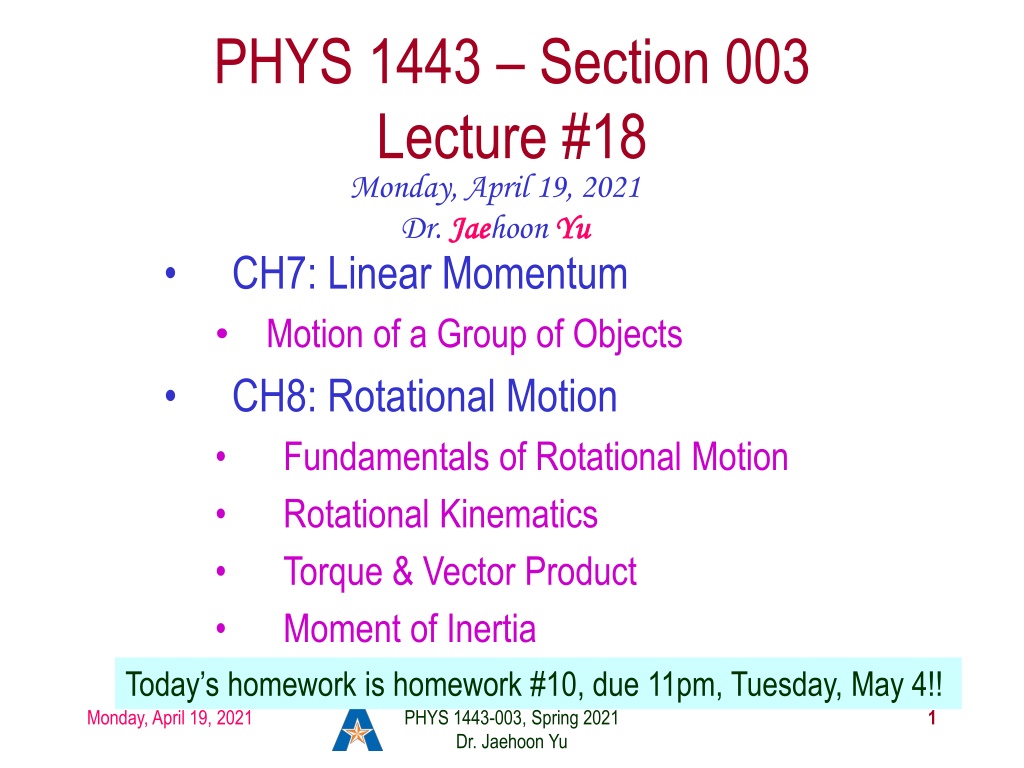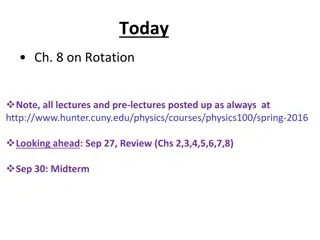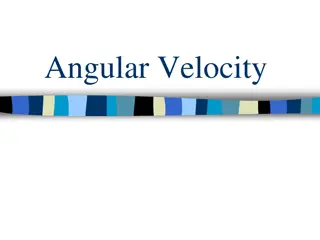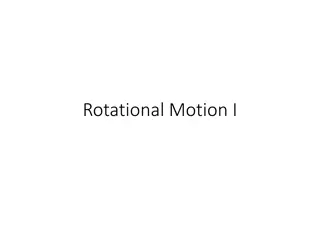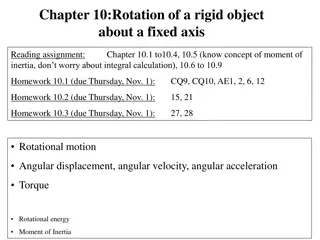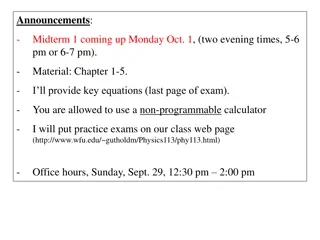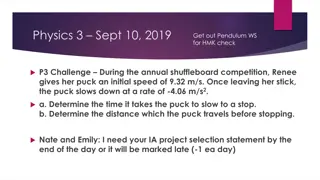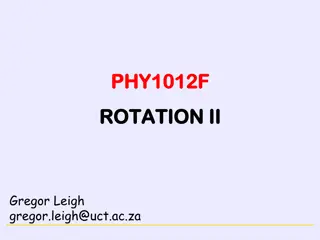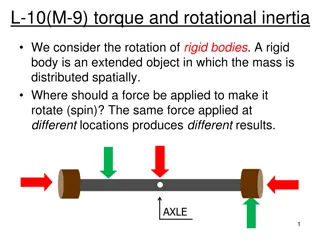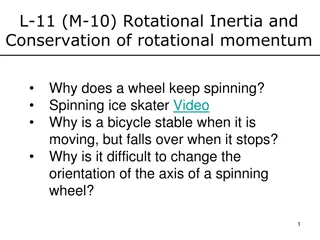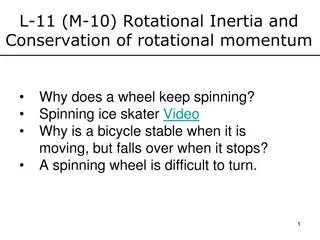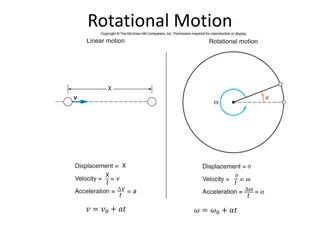Understanding Linear and Rotational Motion in Physics
Explore the concepts of linear momentum, center of mass, rotational motion, and angular displacement in physics. Learn how to determine the center of mass of objects, analyze motion of particle groups, and understand the conservation of momentum in systems under external forces. Delve into the fundamentals of rotational motion, including torque, moment of inertia, and angular kinematics. Discover the importance of symmetry, equilibrium, and gravitational forces in describing the motion of objects.
Download Presentation

Please find below an Image/Link to download the presentation.
The content on the website is provided AS IS for your information and personal use only. It may not be sold, licensed, or shared on other websites without obtaining consent from the author. Download presentation by click this link. If you encounter any issues during the download, it is possible that the publisher has removed the file from their server.
E N D
Presentation Transcript
PHYS 1443 Section 003 Lecture #18 Monday, April 19, 2021 Dr. Jae Jaehoon Yu CH7: Linear Momentum Motion of a Group of Objects CH8: Rotational Motion Fundamentals of Rotational Motion Rotational Kinematics Torque & Vector Product Moment of Inertia Today s homework is homework #10, due 11pm, Tuesday, May 4!! Yu Monday, April 19, 2021 PHYS 1443-003, Spring 2021 Dr. Jaehoon Yu 1
Announcements The skipped homework #9 is due 11pm, Tuesday, April 27!! Special project #6 deadline extended to next Monday, Apr. 26 2nd non-comprehensive exam results Class average: 63.3/102 Equivalent to 62/100 Previous results: 77.3/100 and 50.2/100 Top score: 96/102 Evaluation Policy Homework: 25% Final exam: 23% Mid-term exam: 20% One better of the two term exams: 12% Lab: 10% Quizzes: 10% Extra credit: 10% Monday, April 19, 2021 PHYS 1443-003, Spring 2021 Dr. Jaehoon Yu 2
Center of Mass and Center of Gravity The center of mass of any symmetric object lies on the axis of symmetry and on any plane of symmetry, if the object s mass is evenly distributed throughout the body. One can use gravity to locate CM. 1. Hang the object by one point and draw a vertical line following a plum-bob. 2. Hang the object by another point and do the same. 3. The point where the two lines meet is the CM. Since a rigid object can be considered as a collection of small masses, one can see the total gravitational force exerted on the object as CM Axis of symmetry How do you think you can determine the CM of the objects that are not symmetric? Center of Gravity mi The net effect of these small gravitational forces is equivalent to a single force acting on a point (Center of Gravity) with mass M. What does this equation tell you? mig g Monday, April 19, 2021 The CoG is the point in an object as if all the gravitational force is acting on! PHYS 1443-003, Spring 2021 Dr. Jaehoon Yu 3
Motion of a Group of Particles We ve learned that the CM of a system can represent the motion of a system. Therefore, for an isolated system of many particles in which the total mass M is preserved, the velocity, total momentum, acceleration of the system are i mivi = 1 M midri dt drCM dt 1 M i d dt i i mivi = vCM= = Velocity of the system miri M Total Momentum of the system i = i pCM= = = =ptot MvCM= dvCM dt M mivi pi M i miai = 1 M 1 M d dt dvi dt Acceleration of the system i i aCM= = mivi mi M a = The external force acting on the system What about the internal forces? dptot dt i Ma = = mi Fext dptot dt System s momentum is conserved. = ptot=const 0= Fext If net external force is 0 Monday, April 19, 2021 PHYS 1443-003, Spring 2021 Dr. Jaehoon Yu 4
Rotational Motion and Angular Displacement In the simplest kind of rotation, all points on a rigid object move on circular paths around an axis of rotation. The angle swept out by the line passing through any point on the body and intersecting the axis of rotation perpendicularly is called the displacement. = angular o It s a vector!! So, there must be a direction (poll 6) +:if counter-clockwise -:if clockwise How do we define directions? Monday, April 19, 2021 The direction vector points gets determined based on the right-hand rule. PHYS 1443-003, Spring 2021 Dr. Jaehoon Yu 5 These are just conventions!!
SI Unit of the Angular Displacement Arc length Radius =s (in radians) = r Dimension? None For one full revolution: Since the circumference of a circle is 2 r =2 rad 2 r r 2p rad = = 360 One radian is an angle subtended by an arc of the same length as the radius! Monday, April 19, 2021 PHYS 1443-003, Spring 2021 Dr. Jaehoon Yu 6
Unit of the Angular Displacement How many degrees are in one radian? 1 radian is 360 2prad 1rad =180 1 rad= o 57.3 p How radians is one degree? And one degrees is How many radians are in 10.5 revolutions? 3.141 180 2 o = = 1 1 0.0175rad 1 o 360 180 rad rev ( ) 10.5rev = 21 rad = 10.5 2 rev Very important: In solving angular problems, all units, degrees or revolutions, must be converted to radians! Monday, April 19, 2021 PHYS 1443-003, Spring 2021 Dr. Jaehoon Yu 7
Example A particular bird s eyes can distinguish objects that subtend an angle no smaller than about 3x10-4 rad. (a) How many degrees is this? (b) How small an object can the bird just distinguish when flying at a height of 100m? (a) One radian is 360o/2 . Thus 4 3 10 rad = ( 360 2 rad (b) Since l=r and for small angle arc length is approximately the same as the chord length. r = 100 m 2 3 10 ( ) 3 10 rad ) = 4 o o 0.017 l = = 4 3 10 m = rad 3 cm Monday, April 19, 2021 PHYS 1443-003, Spring 2021 Dr. Jaehoon Yu 8
Ex. Adjacent Synchronous Satellites Synchronous satellites are put into an orbit whose radius is 4.23 107m. If the angular separation of the two satellites is 2.00 degrees, find the arc length that separates them. What do we need to find out? The Arc length!!! =Arc length Radius =s (in radians) r = 2 rad 360deg Convert degrees to radians 0.0349 rad 2.00deg r =( 1.48 10 m (920 miles) )( ) s = 4.23 10 m 0.0349 rad 7 = 6 Monday, April 19, 2021 PHYS 1443-003, Spring 2021 Dr. Jaehoon Yu 9
Ex. A Total Eclipse of the Sun The diameter of the Sun is about 400 times greater than that of the moon. By coincidence, the sun is also about 400 times farther from the earth than is the moon. For an observer on the earth, compare the angle subtended by the moon to the angle subtended by the sun and explain why this result leads to a total solar eclipse. (in radians) Arc length Radius = s r = I can even cover the entire sun with my thumb!! Why? Because the distance (r) from my eyes to my thumb is far shorter than that to the sun. Monday, April 19, 2021 PHYS 1443-003, Spring 2021 Dr. Jaehoon Yu 10
Angular Displacement, Velocity, and Acceleration Using what we have learned earlier, how would you define the angular displacement? = f i f i = How about the average angular speed? Unit? rad/s Dimension (poll 5)? [T-1] f t t t f i i d lim = And the instantaneous angular speed? Unit? rad/s Dimension (poll 5)? [T-1] t dt 0 t By the same token, the average angular acceleration is defined as Unit? rad/s2 Dimension (poll 5)? [T-2] f i = t t t f i d And the instantaneous angular acceleration? lim = Unit? rad/s2 t dt 0 t When rotating about a fixed axis, every particle on a rigid object rotates through the same angle and has the same angular speed and angular acceleration. Monday, April 19, 2021 PHYS 1443-003, Spring 2021 Dr. Jaehoon Yu 11
Rotational Kinematics The first type of motion we have learned in linear kinematics was under the constant acceleration. We will learn about the rotational motion under constant angular acceleration, because these are the simplest motions in both cases. Just like the case in linear motion, one can obtain Angular velocity under constant angular acceleration: Linear kinematics Angular displacement under constant angular acceleration: Linear kinematics One can also obtain Linear kinematics Monday, April 19, 2021 PHYS 1443-003, Spring 2021 Dr. Jaehoon Yu 12
Problem Solving Strategy Visualize the problem by drawing a picture. Write down the values that are given for any of the five kinematic variables and convert them to SI units. Remember that the unit of the angle must be radians!! Verify that the information contains values for at least three of the five kinematic variables. Select the appropriate equation. When the motion is divided into segments, remember that the final angular velocity of one segment is the initial velocity for the next. Keep in mind that there may be two possible answers to a kinematics problem. Monday, April 19, 2021 PHYS 1443-003, Spring 2021 Dr. Jaehoon Yu 13
Ex. Rotational Kinematics A wheel rotates with a constant angular acceleration of 3.50 rad/s2. If the angular speed of the wheel is 2.00 rad/s at ti=0, a) through what angle does the wheel rotate in 2.00s? Using the angular displacement formula in the previous slide, one gets 1 2 = + 2 t t f i 1 ( . 2 ) 2 = = + 11 0 . rad . 2 00 . 2 00 . 3 50 00 2 11 0 . = rev = . . 1 75 . rev 2 Monday, April 19, 2021 PHYS 1443-003, Spring 2021 Dr. Jaehoon Yu 14
Example for Rotational Kinematics cntd What is the angular speed at t=2.00s? Using the angular speed and acceleration relationship = + t = + = . 2 00 . 3 50 . 2 00 . 9 00 rad / s f i Find the angle through which the wheel rotates between t=2.00s and t=3.00s. How many revolution is it? 1 = + 11.0rad 2 t t Using the angular kinematic formula f i 2 13.50 2.00 2 13.50 2 = t == + 2.00 2.00 At t=2.00s 2 ( ) 2 t == + 2.00 3.00 = 3.00 21.8rad At t=3.00s 3 10 8 . = 2 = 10 8 . rad Angular displacement = rev = . . 1 72 . rev 2 Monday, April 19, 2021 PHYS 1443-003, Spring 2021 Dr. Jaehoon Yu 15
Relationship Between Angular and Linear Quantities What do we know about a rigid object that rotates about a fixed axis of rotation? Every particle (or masslet) in the object moves in a circle centered at the same axis of rotation. When a point rotates, it has both the linear and angular components in its motion. What is the linear component of the motion you see? Linear velocity along the tangential direction. How do we relate this linear component of the motion with angular component? r = So, the tangential speed vis The direction of follows the righthand rule. = r dl dt d d dt v ( ) l = = = The arc-length is r rdt What does this relationship tell you about the tangential speed of the points in the object and their angular speed?: Although every particle in the object has the same angular speed, its tangential speed differs and is proportional to its distance from the axis of rotation. The farther away the particle is from the center of Monday, April 19, 2021 PHYS 1443-003, Spring 2021 Dr. Jaehoon Yu rotation, the higher the tangential speed. 16
Is the lion faster than the horse? A rotating carousel has one child sitting on a horse near the outer edge and another on a lion halfway out from the center. (a) Which child has the greater linear speed? (b) Which child has the greater angular speed? (a) Linear speed is the distance traveled divided by the time interval. So, the child sitting at the outer edge travels more distance within the given time than the child sitting closer to the center. Thus, the horse is faster than the lion. (b) Angular speed is the angle traveled divided by the time interval. The angle both the children travel in the given time interval is the same. Thus, both the horse and the lion have the same angular Monday, April 19, 2021 speed. PHYS 1443-003, Spring 2021 Dr. Jaehoon Yu 17
How about the acceleration? How many different linear acceleration components do you see in a circular motion and what are they? Two Tangential, a at t, and the radial acceleration, a ar r. r v = dv dt Since the tangential speed v v is The magnitude of tangential acceleration atis d dt d dt = r ( ) ta = = = r r Although every particle in the object has the same angular acceleration, its tangential acceleration differs proportional to its distance from the axis of rotation. v2 = What does this relationship tell you? ( ) 2 r = r 2 r a The radial or centripetal acceleration aris = r r What does this tell you? The father away the particle is from the rotation axis, the more radial acceleration it receives. In other words, it receives more centripetal force. a r t a a + = ( r = ( ) ) 2 Total linear acceleration is 2 2 2 + r = r + 2 2 4 Monday, April 19, 2021 PHYS 1443-003, Spring 2021 Dr. Jaehoon Yu 18
